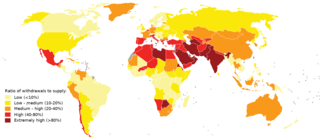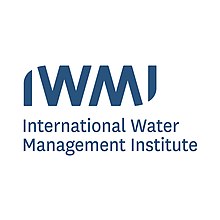
Agricultural science is a broad multidisciplinary field of biology that encompasses the parts of exact, natural, economic and social sciences that are used in the practice and understanding of agriculture. Professionals of the agricultural science are called agricultural scientists or agriculturists.

An agricultural subsidy is a government incentive paid to agribusinesses, agricultural organizations and farms to supplement their income, manage the supply of agricultural commodities, and influence the cost and supply of such commodities.
The only mandated international agricultural research organization is the CGIAR The CGIAR Fund supports 15 international agricultural research centers such as the International Water Management Institute (IWMI), International Rice Research Institute (IRRI), the International Institute of Tropical Agriculture (IITA), the International Livestock Research Institute (ILRI), the International Food Policy Research Institute (IFPRI) and the Center for International Forestry Research that form the CGIAR Consortium of International Agricultural Research Centers and are located in various countries worldwide, The centers carry out research on various agricultural commodities, livestock, fish, water, forestry, policy and management.

CGIAR is a global partnership that unites international organizations engaged in research about food security. CGIAR research aims to reduce rural poverty, increase food security, improve human health and nutrition, and sustainable management of natural resources.

The International Crops Research Institute for the Semi-Arid Tropics (ICRISAT) is an international organisation which conducts agricultural research for rural development, headquartered in Patancheru, Hyderabad, Telangana, India, with several regional centres and research stations . It was founded in 1972 by a consortium of organisations convened by the Ford- and the Rockefeller- foundations. Its charter was signed by the FAO and the UNDP.

The International Food Policy Research Institute (IFPRI) is an international agricultural research center founded in 1975 to improve the understanding of national agricultural and food policies to promote the adoption of innovations in agricultural technology. Additionally, IFPRI was meant to shed more light on the role of agricultural and rural development in the broader development pathway of a country. The mission of IFPRI is to provide research-based policy solutions that sustainably reduce poverty and end hunger and malnutrition.
The Indian government has, since war, subsidised many industries and products, from fuel to gas.

Water scarcity is the lack of fresh water resources to meet the standard water demand. There are two types of water scarcity namely physical and economic water scarcity. Physical water scarcity is where there is not enough water to meet all demands, including that needed for ecosystems to function. Arid areas for example Central and West Asia, and North Africa often experience physical water scarcity. Economic water scarcity on the other hand, is the result of lack of investment in infrastructure or technology to draw water from rivers, aquifers, or other water sources. It also results from weak human capacity to meet water demand. Much of Sub-Saharan Africa experience economic water scarcity.

Water resources are natural resources of water that are potentially useful for humans, for example as a source of drinking water supply or irrigation water. 97% of the water on Earth is salt water and only three percent is fresh water; slightly over two-thirds of this is frozen in glaciers and polar ice caps. The remaining unfrozen freshwater is found mainly as groundwater, with only a small fraction present above ground or in the air. Natural sources of fresh water include surface water, under river flow, groundwater and frozen water. Artificial sources of fresh water can include treated wastewater and desalinated seawater. Human uses of water resources include agricultural, industrial, household, recreational and environmental activities.

Farm water, also known as agricultural water, is water committed for use in the production of food and fibre and collecting for further resources. In the US, some 80% of the fresh water withdrawn from rivers and groundwater is used to produce food and other agricultural products. Farm water may include water used in the irrigation of crops or the watering of livestock. Its study is called agricultural hydrology.
The Basin Focal Projects (BFPs) are a set of CGIAR Challenge Program on Water and Food projects aimed at identifying and catalyzing the implementation of strategic interventions to enhance human and ecological well-being through increases in river basin and local level water productivity.
Deficit irrigation (DI) is a watering strategy that can be applied by different types of irrigation application methods. The correct application of DI requires thorough understanding of the yield response to water and of the economic impact of reductions in harvest. In regions where water resources are restrictive it can be more profitable for a farmer to maximize crop water productivity instead of maximizing the harvest per unit land. The saved water can be used for other purposes or to irrigate extra units of land. DI is sometimes referred to as incomplete supplemental irrigation or regulated DI.
The Columbia Water Center (CWC) was established in January 2008 as Columbia University branch Earth institute on researching and addressing global water-related challenges, including water scarcity, access and quality, alongside Climate risks and changes.

Water scarcity in Africa is predicted to reach dangerously high levels by 2025 when it is estimated that about two-thirds of the world's population may suffer from fresh water shortage. The main causes of water scarcity in Africa are physical and economic scarcity, rapid population growth, and climate change. Water scarcity is the lack of fresh water resources to meet the standard water demand. Although Sub-Saharan Africa has a plentiful supply of rainwater, it is seasonal and unevenly distributed, leading to frequent floods and droughts. Additionally, prevalent economic development and poverty issues, compounded with rapid population growth and rural-urban migration have rendered Sub-Saharan Africa as the world's poorest and least developed region.
Crops For the Future, known by its acronym CFF, is an independent international organisation with a mandate to promote and facilitate the greater use of neglected and underutilised crops for enhanced diversification of agricultural systems and human diets, particularly for the benefit of poor people in developing countries. Crops for the Future is the only such organisation exclusively dedicated to an agenda increasingly recognised as important to achieving food security in a sustainable manner and making use of local agricultural biodiversity. Crops for the Future is based in Semenyih, Malaysia, and is governed by a Board of Directors, including a representative of the Government of Malaysia.
Rainfed agriculture is a type of farming that relies on rainfall for water. It provides much of the food consumed by poor communities in developing countries. E.g., rainfed agriculture accounts for more than 95% of farmed land in sub-Saharan Africa, 90% in Latin America, 75% in the Near East and North Africa, 65% in East Asia, and 60% in South Asia.
The Regional Strategic Analysis and Knowledge Support System (ReSAKSS) was established in 2006 and compiles and analyzes information to help design and evaluate rural development strategies and monitor the progress of the Comprehensive Africa Agriculture Development Programme (CAADP). CAADP is a program of the African Union and the New Partnership for Africa's Development (NEPAD), which aims to increase the share of national budgets allocated to agriculture.

Water, Land and Ecosystems is one of several new research programmes approved by the CGIAR during 2011 after an extensive period of consultation that began in 2009. This research programme will draw on the resources of 14 CGIAR and numerous external partners to provide a more integrated approach to research into managing natural resources. The aim of the research programme is to increase agricultural productivity while protecting the environment, so food security is ensured for most of humanity and that poverty becomes history. The five main strands to the programme are: River basins; Irrigation systems; Information systems; Resource reuse and recovery; and Rainfed agriculture systems.
Jyotigram Yojana is an initiative of the Government of Gujarat, India, to ensure that a 24-hour, three-phase quality power supply is available to rural areas of the state and supply power to farmers residing in scattered farmhouses through feeder lines with specially designed transformers. The scheme was announced in 2006 by the President of India, A. P. J. Abdul Kalam. In 2011 it was announced by the Government of India that it would accept Gujarat's Jyotigram project as a flagship scheme for its Twelfth five-year plan.

International Center for Biosaline Agriculture (ICBA) is an international, not-for-profit applied agricultural research center with a unique focus on marginal environments. It identifies, tests and introduces resource-efficient, climate-smart crops and technologies that are best suited to different regions affected by salinity, water scarcity and drought. Through its work, ICBA aims to improve food security, nutrition and livelihoods of resource-poor farming communities around the world.










